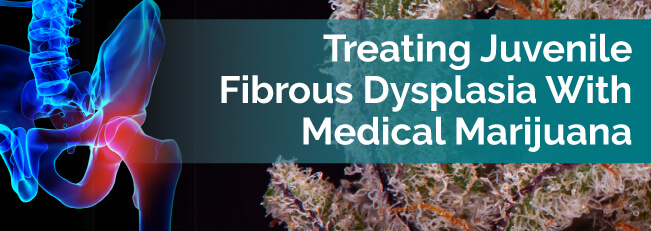
Fibrous dysplasia is a benign condition, but if left untreated it can affect the life of your child. Bones become fragile or prone to break because normal bone is replaced with soft and stringy fibrous tissue. The disorder usually crops up in children between the ages of 3 and 15. It commonly affects only one bone (monostotic), but multiple bone fibrous dysplasia (polyostotic) can occur.
In most cases, the disorder is mild, and parents may not even notice their child has the condition. However, if your child has a severe case of juvenile fibrous dysplasia, it’s advisable to seek medical advice, as the disorder can lead to other complications.
Although medical marijuana is not a cure for fibrous dysplasia, it could be a good alternative to surgery, especially while a child or adolescent’s bones are still developing. Many people discredit using cannabis as a treatment for children because of its psychotropic side effects. However, with its many distinct advantages to certain pain meds, it may be a safer alternative. Plus, marijuana medications have been produced that have little to no risk of getting a user “high.”
Fibrous dysplasia is not inherited. It’s thought to be caused by a gene mutation in the bone of those affected. The most common bones impacted are the skull and face and the long bones, like the humerus, tibia or femur. There are some characteristics parents can look for if they believe their child has juvenile fibrous dysplasia:
Sadly, the condition is sometimes accompanied by complications that can worsen if left untreated:
Children with severe cases of fibrous dysplasia sometimes have fractures or deformities that cause pain or functional impairment. In these cases, immediate treatment is needed.
The three most common forms of treatment don’t cure fibrous dysplasia, but they do help manage pain and strengthen bones. Although these options have found success in adult patients, they may not be the right choice for children and adolescents with the condition.
Because marijuana is relegated by many as an illegal drug, it’s often not considered a beneficial medical option. However, because of astounding reports from parents who have treated their children’s illnesses with medical marijuana, people are starting to take a second look. Children with epilepsy and cancer have experienced favorable results from the herb.
Surgery and medication are pretty much the only treatment options for patients with fibrous dysplasia. However, these choices may not be suitable for children. Marijuana is illegal federally, but it has been approved by many states for children and adolescents with qualifying medical conditions.
Cannabis treatments offer incredible benefits to fibrous dysplasia patients of all ages. Plus, with the advent of strains high in the cannabinoid CBD, these medications are non-psychoactive, meaning they have all the medicinal value without getting users “high.” Some of the fibrous dysplasia symptoms aided by medical marijuana include:
New studies are finding there may be a link between cannabis and bone health. This means we may soon be seeing medical marijuana treatments to prevent fractures and help patients heal after the fact.
If you think marijuana is a good treatment option for your child’s juvenile fibrous dysplasia, it’s essential to contact their doctor. Any therapeutic decisions should be discussed with them, as they know the specifics of your child’s medical history. Also, medical cannabis is only legal to children with the consent of a qualified physician.
For more information about medical marijuana and its positive effects on juvenile fibrous dysplasia, contact a medical marijuana-certified doctor near you or one of your state’s medical marijuana dispensaries.
For more information about how cannabis can be used to treat Fibrous Dysplasia, check out our resources: